Start of cold war
Key factors in the emergence of the Cold War until 1955
Wartime alliance tensions
The alliance of the USA and the USSR during World War 2 was threatened by a number of issues:
the USA delayed opening a second front in France until 1944 - sparking fears the Soviets might seek a separate peace deal with Germany
the USSR refused to support the Polish army during the Warsaw Uprising of August 1944
British and US officials excluded the Soviets from secret talks with the Germans to secure the surrender of their troops in Italy
The end of World War Two
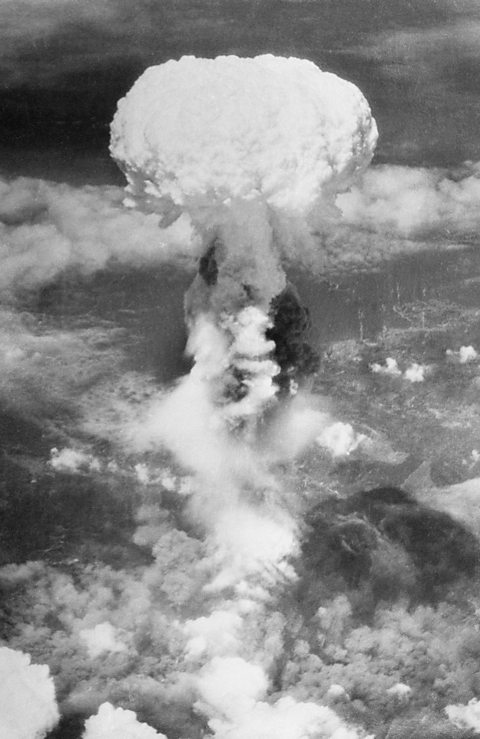
Figure caption,
The destruction of Nagasaki
In August 1945 the USA detonated two atomic bombs over the Japanese cities of Hiroshima and Nagasaki. The intention was to force Japan to surrender, thus avoiding a long war in the Pacific.
This action had the added potential of pressurizing the USSR into negotiating over Eastern Europe and Germany.
However, the fact that US President Truman did not inform Stalin of his intent to deploy nuclear weapons had the opposite effect.
Stalin was offended and his suspicion and distrust of the West intensified. Through his spy network, Stalin had known about Truman’s nuclear weapons for months.
The American victory in the Pacific, without Soviet help, meant the USSR was denied any share of the occupation in that area. This alienated Stalin further.
Development of the arms race
In 1949, the USSR tested its first atomic bomb. This led to a race between the two superpowers to amass the most powerful nuclear weapons with the most effective delivery systems.
In 1953, both the USA and the USSR were testing hydrogen bombs and it appeared to the Americans that the Soviets had caught up technologically. Both sides feared falling behind in research and production.
Eventually, nuclear weapons became a deterrent rather than a weapon for use in warfare. The theory of mutually assured destruction (MAD) championed the view that a superpower would not fire its nuclear weapons as the other side would automatically do the same. This theory relied on neither side having the potential for a ‘first strike’ (the ability to destroy the other side with an intensive nuclear strike, before they attacked).
Truman’s aim of intimidating the USSR into compliance over Eastern Europe backfired. Stalin reacted with anger rather than fear. Tension was greatly increased as a result of the developing arms race which served to militarise both sides and bring war closer.
Ideological differences
The ideological schism that had developed since World War One was clear at the peace conferences of Yalta and Potsdam in 1945. The aim of the conferences was to help the allies decide what would happen to Europe, and in particular Germany, at the end of World War Two.
Emergence of communism
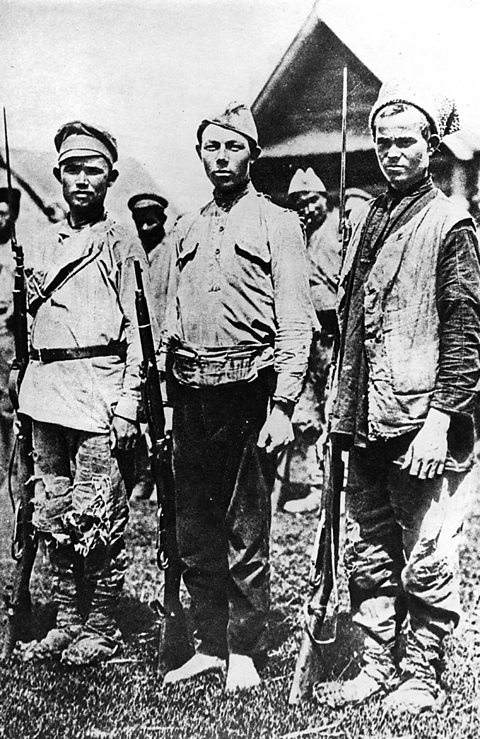
Figure caption,
Bolshevik soldiers
Prior to World War Two some events led to the alienation of the emerging superpowers from each other:
The Bolshevik Revolution of October 1917, which replaced Russia's Provisional Government with a "dictatorship of the proletariat", had established a communist state. The Bolsheviks had withdrawn Russia from World War One, leaving Britain and France to fight alone.
After World War One, the White Army, Tsarist supporters who fought the Bolsheviks during the Russian Civil War, were supported militarily by the Western powers of Britain and the USA.
Capitalism vs communism
The political and economic systems of the capitalist USA and communist USSR were incompatible.
In a capitalist state, the economy is largely free from state control, while the government is democratically elected and freedom of speech is cherished.
In contrast, a communist state is administered from the centre, with control of the economy and society strictly in the hands of the Communist Party-led government.
Both sides wanted countries to conform to their adopted ideologies for their own gains.
The impact of World War Two
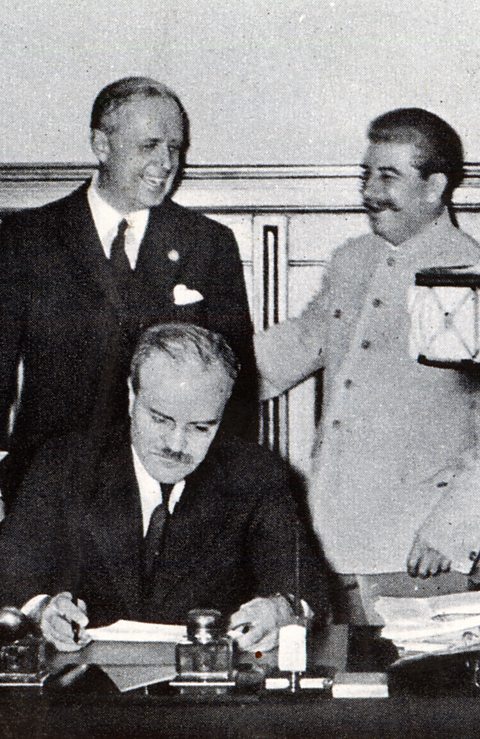
Figure caption,
The signing of the Nazi-Soviet Pact 1939
Events during World War Two further alienated the emerging superpowers.
The Allies were unsure of Stalin’s loyalty as he had allied himself with Hitler in 1939, through the Nazi-Soviet Pact.
Stalin was angry because the USA and Britain had taken so long to open up a 'Second Front' to fight against German forces in Western Europe. This delay allowed Hitler to concentrate his forces against the Soviets.
Stalin suspected that the USA and Britain were leaving Germany and the Soviet Union to fight, so that both countries would be weakened.
This led Stalin to search for increased security for his country in the future. He wanted to create a geographical buffer of friendly Eastern European countries to safeguard against future aggression from the west. This ‘barrier’ was to be created from the lands invaded by the Red Army on its march toward Berlin. The USA was opposed to this as they envisaged the creation of democratic states and free trade.
Disagreements at Yalta and Potsdam between Stalin and the other Allies, mainly over how Eastern Europe was to be administered and restructured, caused further distrust and suspicion.
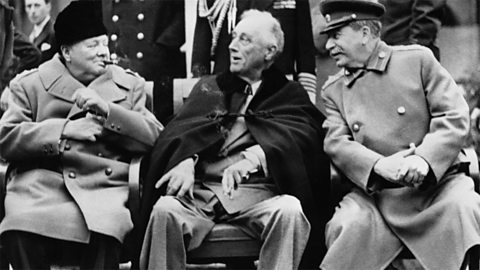
Image caption,
Winston Churchill, Franklin D Roosevelt and Joseph Stalin at the Yalta Conference 1945
Impact of ideological differences on decision-making
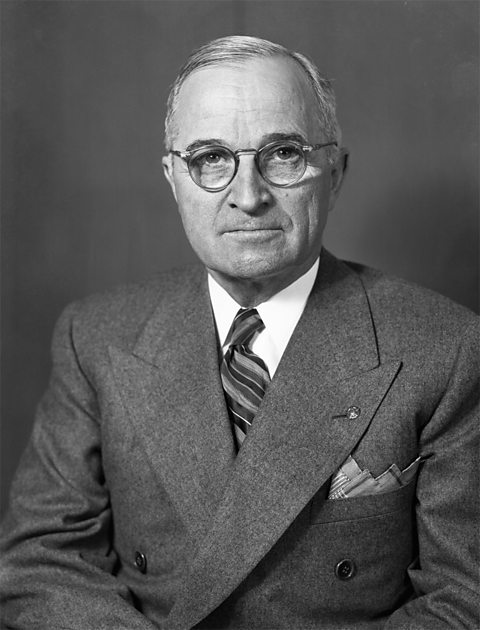
Figure caption,
US President Harry Truman
The decline of Great Britain as a world power after World War Two left a power vacuum. This meant that the USA had to abandon its isolationist tendencies and become more involved in European affairs.
By 1947, Britain had announced that it no longer had the military or economic means to provide aid to the Greek and Turkish governments in their struggle against communist rebels, who were trying to take control of their respective countries.
During a speech in March 1947, US President Truman announced a policy of containment (the realisation that if communism could not be eradicated, it must be prevented from spreading further).
This became known as the Truman Doctrine. He believed that the world was becoming increasingly divided and accused the Soviets of running and encouraging dictatorial regimes and of stifling the world economy.
This attitude was an echo of a speech made by Winston Churchill’s in Fulton, Missouri, USA in 1946. Churchill had announced that an iron curtain has descended across the continent of Europe. He accused the Soviet Union of trying to control Eastern Europe.
In order to ensure containment, the US introduced Marshall Aid. This was the process of delivering economic aid, including food, machinery, building materials, expertise and in some cases money, to countries in Europe that were seen to be in danger of being taken over by communists.
The theory was that if a country was prosperous and its people were happy, then support for communism would not exist.
The divisions caused by ideological differences became clear with the formation of two alliances; NATO and the Warsaw Pact.
The establishment of The North Atlantic Treaty Organisation (NATO) in 1949 aimed to counter the threat of communist expansion in Western Europe.
In reaction to West Germany joining NATO, the Warsaw Pact was established in 1955. Stalin wanted to counter what he regarded as an “aggressive alliance”.
Disagreements over Germany
Ending the War
In July 1945 at the Potsdam Conference, the USA, the USSR and Britain agreed to divide Germany into four zones, until the country was secure enough to be re-unified.
Each zone was to be administered by one of the victorious Allies: the USA, the USSR, Britain and France.
The USSR was to receive most of the reparation payments from Germany to compensate for the country's losses.
However, Stalin wanted to destroy the German economy to ensure that Germany could never rise again. Conversely, the Western Allies wanted Germany to be strong enough that it could contribute to world trade.
Competition between East and West
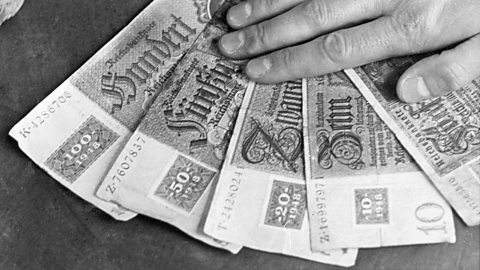
Figure caption,
Ostmarks
While the French, US and British sectors remained free to trade and reconstruction started, Stalin treated the Russian zone harshly. He refused to allow trade with other zones.
He also confiscated much that was produced. He took this, along with a great deal of infrastructure and raw materials, back to the Soviet Union.
In 1947, Bizonia was created as a combination and economic unification of the British and American zones and a new currency, the Deutschmark, was introduced for the Western zones to boost the economy there.
This angered Stalin. He feared these new ideas and currency would spread to the Soviet zone and undermine his efforts to weaken Germany. In response he introduced a new East German currency, the Ostmark.
The Berlin blockade
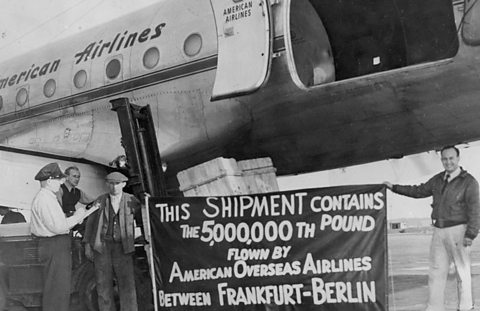
Figure caption,
Marshall Aid was flown into West Berlin after Stalin closed all land routes
West Berlin had become an embarrassment for the communists. Those living in the Soviet sector could see how much better life was in the Allied Sector of the city.
In June 1948, Stalin closed all land routes into Berlin, blocking the Western Allies. He refused to allow Marshall Aid to reach the Soviet zone and hence, West Berlin was cut off. He hoped that this would make the Allies give up their control of Berlin altogether.
The Allies responded by providing much needed supplies through the Berlin airlift operation. For 11 months British and American cargo planes flew from Allied zones into the city at a rate of one every two minutes. Millions of tons of food, fuel and other supplies were delivered.
On May 12th 1949, after 322 days, Stalin lifted the blockade.
Disagreements over how to deal with the German question resulted in tension and arguments that led to the Cold War.
Stalin’s fear of a strong unified Germany put him at odds with American policy to establish an economically strong state which was able to trade effectively and freely with the West.
The resulting Berlin blockade increased tension further, with the possibility of Marshall Aid planes being shot down by the Red Army.
The crisis over Korea
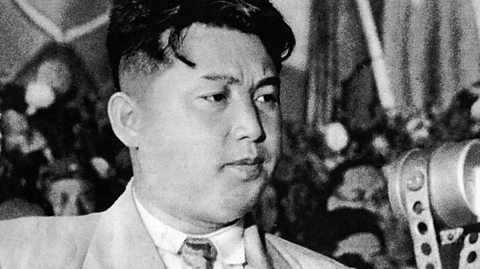
Figure caption,
Kim Il Sung
During World War Two, Korea had been occupied by the Japanese. After the defeat of Japan in 1945, the Korean peninsula was divided at the 38th Parallel, in preparation for elections and reunification.
The communist north was led by Kim Il Sung, the non-communist south by Syngman Rhee.
Communism was growing in the Far East and by 1949, the Communists had taken power in China.
The US developed the 'domino theory' - the idea that, if one country fell to communism, others would follow like a row of dominoes. In 1950, a report by the American National Security Council ('NSC68') recommended that the US stop containment and start to roll back communism.
In 1950, with support from Russia and China, Kim Il Sung invaded South Korea. The North Korean People's Army (NKPA) easily defeated the Republic of Korea's army (the ROKs). By September, the NKPA had conquered almost the whole of South Korea.
The US secured a mandate from the UN to take action against North Korean forces. The Russians were boycotting the UN at the time so could not veto this move.
In September, UN troops, led by US General MacArthur, landed in Korea and drove the NKPA back. By October, the UN forces had almost conquered all of North Korea.
In November 1950, Chinese People's Volunteers attacked and drove the Americans back.They recaptured North Korea, and advanced into South Korea.
The Americans landed more troops and drove the Chinese back to the 38th parallel. The war went on as border clashes until 1953. At this point America's new president, Eisenhower, offered peace, but threatened to use the atomic bomb if China did not accept the offer.
The US realised they could halt the spread of communism using military strength. A new frontline in the Cold War had been drawn in Asia.
This was another area where capitalism and communism met and remains a source of political and economic tension to this day.